
St Mary
Fishponds
Bristol
Fishponds has an attractive almost village-like centre, with an attractive park and still-thriving local shopping centre. The parish church stands behind the park, surrounded by trees, the spire peeking out over the top of them all. In fact the burial ground is older than the first church, being established in 1806. The church of St Giles (now Holy Trinity) Stapleton built a chapel-of-ease known as Stapleton Chapel within the burial ground in 1820, and this in turn became the present parish church of Fishponds in 1869. It was consecrated on August 31st 1821 and dedicated to St Mary.
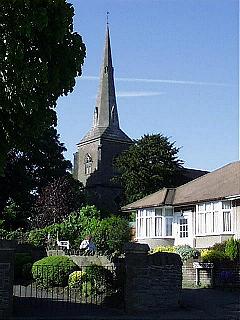 |
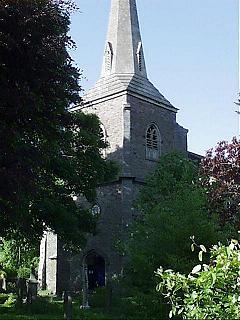 |
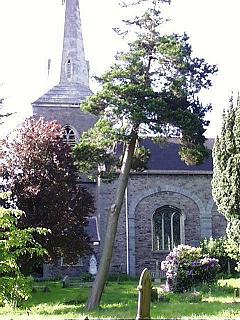 |
The church as built consisted of the present nave, tower and spire. The detailing is poor, the tower rather too low, with the spire appearing to squash it down. The south side is relieved by odd blank arcading, and originally the entrance was in the centre of this south front. The principle entrance is now through the west tower door. The interior was a plain box with a western gallery "for 142 Sunday School and Charity children."
With the advent of parochial status, and the continued growth of population, the church proved to be too small. Preaching boxes were no longer the fashion, where the Victorians preferred a return to ritual and symbolism. No self-respecting church could be without a chancel. And indeed in 1871 an apsidal chancel was provided, but the church was so wide that there was room for a tripartite arch and side aisles. A four-bayed north aisle followed in Edwardian times, making the church even wider, the arcade being of unusual outline, with thin piers.
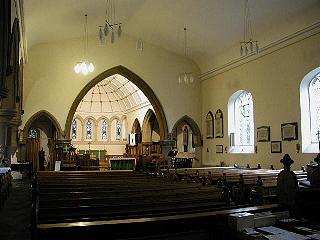 |
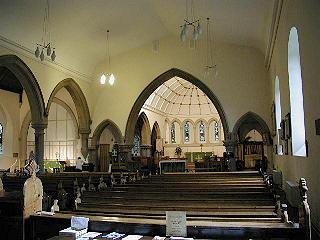 |
The two views above contrast the Georgian nave (the original church) with the High Victorian chancel, lower and narrower with some exuberantly carved capitals. The central piers of each chancel arcade is doubled. A panelled ceiling with small bosses covers these eastern parts, in stark contrast to the plain low-pitched plaster ceiling of the earlier church. The Tudoresque three-light side windows of the original church equally contrast with the small windows of the east end and the large five-light windows of the aisle.
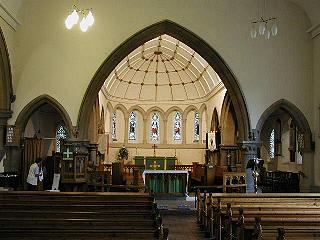 |
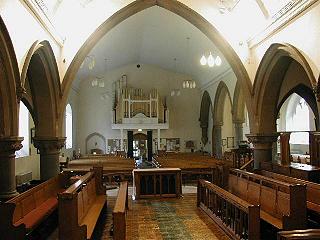 |
The chancel is shown here in close-up but the fittings are fairly standard and inoffensive. Looking back from the sanctuary the wide proprtions of the nave can be appreciated. The large west gallery has gone, replaced by a much smaller one supporting the organ works.
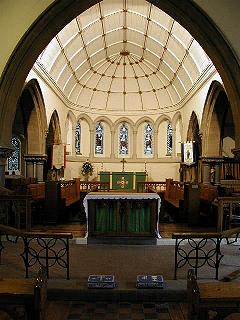 |
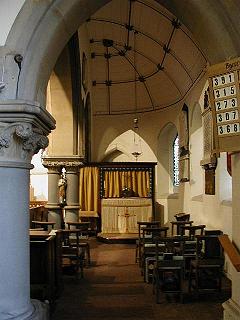 |
Changes to the church have continued and thankfully include the repainting of the chancel ceiling from the turquoise I remember as a schoolboy when we attended from Dr Bell's school. There is a new altar forward of the former chancel steps, with ironwork communion rails. This has necessitated removal of most of the low openwork panelled chancel screen which was here. The south chapel has the same roof which turns at the end and "collides" with the respond of the arcade.
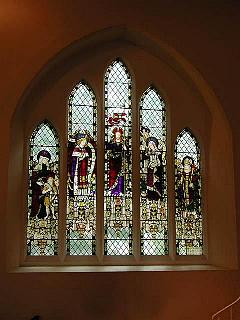 |
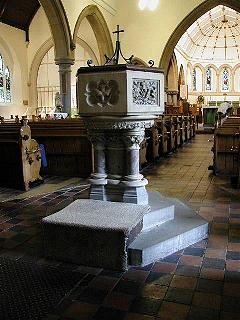 |
The east end of the north aisle was fitted up as a chapel in 1923 and dedicated to St Aidan. The large window on the north side received good glass by Bewsey depicting the Incarnation, Behind to the east are the large vestries, badly damaged in a fire in c1992 and rebuilt as a parish room. At the same time the west bay of the aisle was screened off to form a new choir vestry. Perhaps my favourite feature is the chunky Victorian font which still stands at the west end of the nave to greet visitors.
The parish rooms (St Mary's Hall) in Guinea Lane have now been converted into flats, and the external stonework is pristinely restored. Here was where for three years I had to walk every schoolday for lunch, where the three H's (Mrs Hake, Haddock and Hawkins if my memory serves me correctly) dished up the dinners.
The population of Fishponds continued to grow apace, and St Mary's had been enlarged as far as could be done on the site. New early C20 churches, All Saints in the Thingwall Park/ Grove Road area, and St John the Divine in Lodge Causeway were daughter churches of St Mary.
St Mary's has a website, and is generally open for a couple of hours on weekday mornings. As you might see in the pictures above, one lady was extremely busy polishing the plate and brass, but I was left to my own thoughts and memories, and photography. When I did ask for information from another lady, this was kindly given.
Back to Bristol churches Index